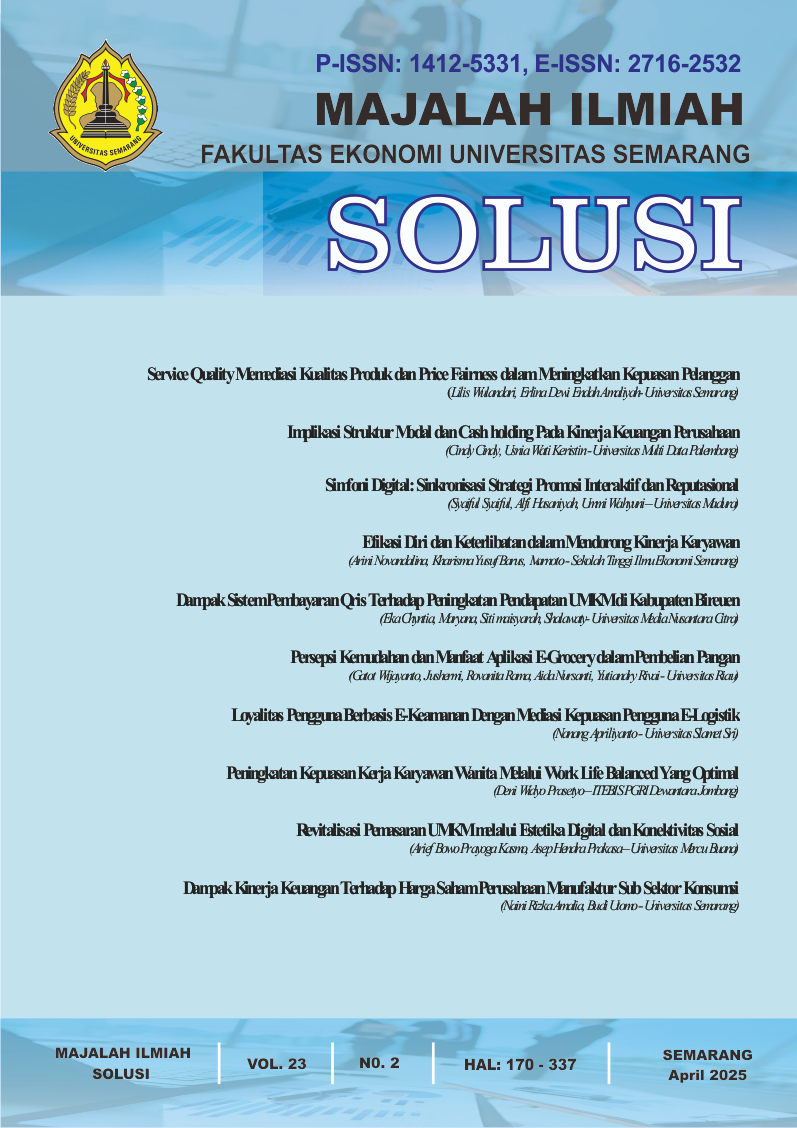Persepsi Kemudahan dan Manfaat Aplikasi E-Grocery dalam Pembelian Pangan
DOI:
https://doi.org/10.26623/slsi.v23i2.11895Abstract
Penelitian ini bertujuan untuk menganalisis penerimaan konsumen Kota Pekanbaru terhadap belanja bahan makanan secara online melalui aplikasi e-grocery dengan menggunakan kerangka Technology Acceptance Model (TAM). Objek penelitian ini adalah 174 responden perempuan berusia 18 tahun ke atas yang pernah menggunakan layanan e-grocery. Pendekatan penelitian yang digunakan adalah kuantitatif deskriptif dengan teknik purposive sampling. Data dianalisis menggunakan metode Structural Equation Modeling-Partial Least Squares (SEM-PLS) melalui perangkat lunak SmartPLS 3. Hasil penelitian menunjukkan bahwa perceived ease of use (PEU) berpengaruh positif dan signifikan terhadap perceived usefulness (PU) dan attitude (ATT). PU juga terbukti berpengaruh terhadap ATT dan behavioral intention (BI). ATT memiliki pengaruh signifikan terhadap BI, namun PEU tidak berpengaruh langsung terhadap BI. Temuan ini mengindikasikan bahwa kemudahan penggunaan aplikasi belum tentu memicu niat untuk menggunakannya, namun manfaat yang dirasakan dan sikap positif terhadap aplikasi berperan penting dalam mendorong perilaku konsumen. Penelitian ini juga menemukan efek mediasi signifikan dari PU dan ATT dalam hubungan antara PEU dan BI. Keunikan penelitian ini terletak pada penerapan model TAM dalam konteks lokal dengan populasi perempuan sebagai pengambil keputusan utama dalam belanja bahan makanan. Implikasi dari studi ini memberikan wawasan strategis bagi pengembang e-grocery dalam mengoptimalkan aspek kemudahan dan manfaat guna meningkatkan niat penggunaan konsumen. Penelitian lanjutan disarankan untuk mempertimbangkan faktor eksternal seperti kepercayaan, kualitas produk, dan perilaku aktual konsumen.
References
Adiyoso, W., & Wilopo. (2021). Social distancing intentions to reduce the spread of COVID-19: The extended theory of planned behavior. BMC Public Health, 21(1). https://doi.org/10.1186/s12889-021-11884-5
Ajzen, I. (1991). The Theory of Planned Behavior. https://doi.org/10.1080/08870446.2011.613995
Al Amin, M., Arefin, M. S., Hossain, I., Islam, M. R., Sultana, N., & Hossain, M. N. (2022). Evaluating the Determinants of Customers’ Mobile Grocery Shopping Application (MGSA) Adoption during COVID-19 Pandemic. Journal of Global Marketing, 35(3), 228–247. https://doi.org/10.1080/08911762.2021.1980640
Anesbury, Z., Nenycz-Thiel, M., Dawes, J., & Kennedy, R. (2016). How do shoppers behave online? An observational study of online grocery shopping. Journal of Consumer Behaviour, 15(3), 261–270. https://doi.org/10.1002/cb.1566
Anitha, V., & Krishnan, A. R. (2022). Customer Intention Towards E-Grocery Shopping Apps Using TAM And UGT. SPECIALUSIS UGDYMAS, 1(43).
Arslan, Y., & Turan, A. H. (2022). CONSUMERS’ ACCEPTANCE OF ONLINE GROCERY SHOPPING IN A PANDEMIC SITUATION: AN EXTENDED TECHNOLOGY ACCEPTANCE MODEL PERSPECTIVE. European Journal of Business Science and Technology, 8(2), 143–158. https://doi.org/10.11118/ejobsat.2022.008
Bauerová, R., & Klepek, M. (2018). Technology acceptance as a determinant of online grocery shopping adoption. Acta Universitatis Agriculturae et Silviculturae Mendelianae Brunensis, 66(3), 737–746. https://doi.org/10.11118/actaun201866030737
Chakraborty, D. (2019). Indian Shoppers’ Attitude Towards Grocery Shopping Apps: A Survey Conducted on Smartphone Users. Metamorphosis: A Journal of Management Research, 18(2), 83–91. https://doi.org/10.1177/0972622519885502
Davis, F. D. (1989). Perceived usefulness, perceived ease of use, and user acceptance of information technology. MIS Quarterly: Management Information Systems, 13(3). https://doi.org/10.2307/249008
Driediger, F., & Bhatiasevi, V. (2019). Online grocery shopping in Thailand: Consumer acceptance and usage behavior. Journal of Retailing and Consumer Services, 48, 224–237. https://doi.org/10.1016/j.jretconser.2019.02.005
Fishbein, M., & Ajzen, I. (1975). Belief, Attitude, and Behaviour: An Introduction to Theory and Research. Belief, Attitude, and Behaviour: An Introduction to Theory and Research, 10(2).
Gomes, S., & Lopes, J. M. (2022). Evolution of the Online Grocery Shopping Experience during the COVID-19 Pandemic: Empiric Study from Portugal. Journal of Theoretical and Applied Electronic Commerce Research, 17(3), 909–923. https://doi.org/10.3390/jtaer17030047
Granić, A., & Marangunić, N. (2019). Technology acceptance model in educational context: A systematic literature review. In British Journal of Educational Technology (Vol. 50, Issue 5, pp. 2572–2593). Blackwell Publishing Ltd. https://doi.org/10.1111/bjet.12864
Hair, J. F., Hult, G. T., Ringle, C., & Sarstedt, M. (2017). A Primer on Partial Least Squares Structural Equation Modeling (PLS-SEM) - Joseph F. Hair, Jr., G. Tomas M. Hult, Christian Ringle, Marko Sarstedt. In Sage.
Hansen, T., Jensen, J. M., & Solgaard, H. S. (2004). Predicting online grocery buying intention: A comparison of the theory of reasoned action and the theory of planned behavior. International Journal of Information Management, 24(6), 539–550. https://doi.org/10.1016/j.ijinfomgt.2004.08.004
Henseler, J., Ringle, C. M., & Sarstedt, M. (2015). A new criterion for assessing discriminant validity in variance-based structural equation modeling. Journal of the Academy of Marketing Science, 43(1). https://doi.org/10.1007/s11747-014-0403-8
Jasti, D., & Syed, A. A. (2019). Leveraging the internet for grocery shopping: A study of factors influencing the Indian consumer. International Journal on Emerging Technologies, 10(3).
Karim, R. A., Rahayu, A., Mahmud, N., Monoarfa, H., Bahtar, A. Z., Nazari, Z. A., & Adirestuty, F. (2021). An application of TAM model towards influencing online purchase intention during Covid-19 pandemic for fresh agricultural products: A preliminary findings. AIP Conference Proceedings, 2347. https://doi.org/10.1063/5.0052849
Kasuma, J., Abdul Razak, F. L., Omar, N., Abang Naim, A. S., Sheikh Naimullah, B. S., & Darma, D. C. (2021). Attitude, Perceived Usefulness and Perceived Ease of Use towards Intention to Use M-Commerce: A Case of Grocery Shoppers in Kuching, Sarawak. Journal of Entrepreneurship and Business, 8(1). https://doi.org/10.17687/jeb.v8i1.451
Kurnia, S., & Chien, A. J. (2003). The Acceptance of Online Grocery Shopping Developing a Conceptual Model of the Acceptance of OGS. Online.
Kurniasari, F., & Riyadi, W. T. (2021). Determinants of Indonesian E-Grocery Shopping Behavior After Covid-19 Pandemic Using the Technology Acceptance Model Approach. In UIJRT | United International Journal for Research & Technology | (Vol. 03, Issue 01). www.redseer.com,
Loketkrawee, P., & Bhatiasevi, V. (2018). Elucidating the Behavior of Consumers toward Online Grocery Shopping: The Role of Shopping Orientation. Journal of Internet Commerce, 17(4). https://doi.org/10.1080/15332861.2018.1496390
Marangunić, N., & Granić, A. (2015). Technology acceptance model: a literature review from 1986 to 2013. Universal Access in the Information Society, 14(1), 81–95. https://doi.org/10.1007/s10209-014-0348-1
Nawi, N. M., Hashim, N. A. A. N., Shahril, Z., & Hamid, R. (2019). Airbnb Physical Environment Attributes and Customer Behavioral Intention: A Proposed Study. International Journal of Academic Research in Business and Social Sciences, 9(8). https://doi.org/10.6007/ijarbss/v9-i8/6230
Nguyen, T. T. H., Nguyen, N., Nguyen, T. B. L., Phan, T. T. H., Bui, L. P., & Moon, H. C. (2019). Investigating consumer attitude and intention towards online food purchasing in an emerging economy: An extended TAM approach. Foods, 8(11). https://doi.org/10.3390/foods8110576
Poon, W. C., & Tung, S. E. H. (2022). The rise of online food delivery culture during the COVID-19 pandemic: an analysis of intention and its associated risk. European Journal of Management and Business Economics. https://doi.org/10.1108/EJMBE-04-2021-0128
Qi, X., Tian, X., & Ploeger, A. (2021). Exploring chinese consumers’ online purchase intentions toward certified food products during the covid-19 pandemic. Foods, 10(11). https://doi.org/10.3390/foods10112729
Rout, K., Sahoo, P. R., Bhuyan, A., Tripathy, A., & Smrutirekha. (2022). Online grocery shopping behavior during COVID-19 pandemic: An interdisciplinary explanation. Cogent Business and Management, 9(1). https://doi.org/10.1080/23311975.2022.2084969
Ruangkanjanases, A., Sirisrisakulchai, P., Natali, & Simamora, B. H. (2021). Predicting Consumer Intention to Adopt Online Grocery Shopping: A Comparative Study between Millennials in Thailand and Indonesia. International Journal of Electronic Commerce Studies, 12(2), 193–208. https://doi.org/10.7903/ijecs.1894
Ryadi, W. T., Kurniasari, F., & Sudiyono, K. A. (2021). Factors influencing consumer’s intention towards e-grocery shopping: An extended technology acceptance model approach. Economics, Management and Sustainability, 6(2), 146–159. https://doi.org/10.14254/jems.2021.6-2.11
Saleem, A., Aslam, J., Kim, Y. B., Nauman, S., & Khan, N. T. (2022). Motives towards e-Shopping Adoption among Pakistani Consumers: An Application of the Technology Acceptance Model and Theory of Reasoned Action. Sustainability (Switzerland), 14(7). https://doi.org/10.3390/su14074180
Shukla, A., & Sharma, S. K. (2018). Evaluating Consumers’ Adoption of Mobile Technology for Grocery Shopping: An Application of Technology Acceptance Model. Vision, 22(2). https://doi.org/10.1177/0972262918766136
Sitorus, H. M., & Vania, C. (2022). NIAT ADOPSI TEKNOLOGI ONLINE GROCERY SHOPPING: EKSTENSI TECHNOLOGY ACCEPTANCE MODEL. Jurnal Rekayasa Sistem Industri, 11(1), 93–100. https://doi.org/10.26593/jrsi.v11i1.5204.93-100
Troise, C., O’Driscoll, A., Tani, M., & Prisco, A. (2021). Online food delivery services and behavioural intention – a test of an integrated TAM and TPB framework. British Food Journal, 123(2), 664–683. https://doi.org/10.1108/BFJ-05-2020-0418
Tyrväinen, O., & Karjaluoto, H. (2022). Online grocery shopping before and during the COVID-19 pandemic: A meta-analytical review. In Telematics and Informatics (Vol. 71). Elsevier Ltd. https://doi.org/10.1016/j.tele.2022.101839
Venkatesh, V., & Davis, F. D. (2000). Theoretical extension of the Technology Acceptance Model: Four longitudinal field studies. Management Science, 46(2), 186–204. https://doi.org/10.1287/mnsc.46.2.186.11926
Warganegara, D. L., & Hendijani, R. B. (2022). Factors That Drive Actual Purchasing of Groceries through E-Commerce Platforms during COVID-19 in Indonesia. Sustainability (Switzerland), 14(6). https://doi.org/10.3390/su14063235
Downloads
Published
Issue
Section
License
Copyright (c) 2025 Gatot Wijayanto, Jushermi, Rovanita Rama, Aida Nursanti, Yutiandry Rivai

This work is licensed under a Creative Commons Attribution 4.0 International License.
The author who will publish the manuscript at Solusi : Journal of Solusi, agree to the following terms:
|













 This work is licensed under a
This work is licensed under a 